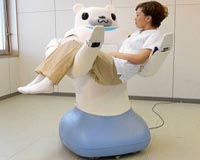 |
Tokyo (AFP) Sept 11, 2009 Japan on Friday launched its first unmanned cargo spacecraft to the International Space Station, aiming for a share of space transport after the retirement of the US space shuttle fleet next year. The Japan Aerospace Exploration Agency (JAXA) launched the HTV transportation vehicle atop an H-2B rocket, which is also on its first flight, as scheduled just after 2:00 am (1700 GMT Thursday), agency images showed. The vehicle separated from the rocket, as planned, about 15 minutes later. "We want to build on this success and continue the programme," JAXA president Keiji Tachikawa told a news conference. The agency plans to launch one such cargo spacecraft every year until 2015. The rocket blasted off from the Tanegashima Space Centre on a southern Japanese island, with the HTV carrying 4.5 tonnes of supplies including food and daily necessities for the six ISS crew, as well as materials for experiments, such as seeds for growing plants in space. Later this month, astronauts will for the first time operate a Canadian robotic arm at the ISS to grab the HTV and dock it as the vehicle approaches the station. The 10-metre (33-foot) long cylindrical vehicle, which cost 20 billion yen (217 million dollars), will deliver the supplies, load waste materials and return to Earth, burning up as it reenters the atmosphere. Japan has spent 68 billion yen developing the vehicle, which could be modified in future to carry humans. Japan currently has no spacecraft that can send people into space. But, like China and India, it has been stepping up its space operations and in June ended the world's most extensive mission to the moon in decades, using an unmanned lunar orbiter. It hopes to send an astronaut there by 2020. Japan faced an embarrassing failure in November 2003, when it had to destroy a rocket carrying a spy satellite 10 minutes after lift-off because one of the rocket boosters failed to separate from the fuselage. Mitsubishi Heavy Industries, which helped develop the H-2B programme, hailed Friday's successful launch. "Until now, we have not been able to meet wishes of our clients to launch large satellites," said Hideaki Omiya, Mitsubishi Heavy president. "But H-2B allows us to meet most of the requests." The HTV can carry up to six tonnes of supplies to the ISS, compared with 7.5 tonnes for the Automated Transfer Vehicle developed by the European Space Agency, and 2.5 tonnes for Russia's Progress spacecraft, the Japanese agency said. Share This Article With Planet Earth
Related Links All about the robots on Earth and beyond!
 Robot created to work in care facilities
Robot created to work in care facilitiesTokyo (UPI) Sep 2, 2009 Japanese scientists say they've built a robot designed to cope with the world's aging population by assisting staff and patients at care facilities. Researchers at the Riken Center for Developmental Biology in Tokyo and Japan's Tokai Rubber Industries Ltd. named the robot Riba -- Robot for Interactive Body Assistance. The scientists said Ribia makes use of the latest in sensor, c ... read more |
|
| The content herein, unless otherwise known to be public domain, are Copyright 1995-2009 - SpaceDaily. AFP and UPI Wire Stories are copyright Agence France-Presse and United Press International. ESA Portal Reports are copyright European Space Agency. All NASA sourced material is public domain. Additional copyrights may apply in whole or part to other bona fide parties. Advertising does not imply endorsement,agreement or approval of any opinions, statements or information provided by SpaceDaily on any Web page published or hosted by SpaceDaily. Privacy Statement |